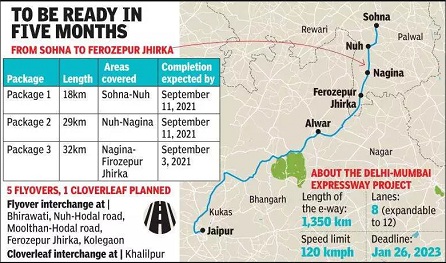In another few months, the ride from Jaipur to Delhi-NCR may bring you on such a new route that is part of the larger Delhi-Mumbai Expressway. After construction, the first section of the expressway, which runs from Sohna to Jaipur, must reduce the traffic congestion on NH-8, the main Delhi-Gurugram-Jaipur corridor, which has been extremely congested in recent years and helps travellers minimise their journey time.
As per the National Highways Authority of India, five flyovers and one truss bridge will be constructed on the Sohna-Ferozepur Jhirka section of that same expressway (NHAI). There will still be five more crossings along this section, allowing travelers to enter and exit this green-field expressway.
According to a senior NHAI official, the Delhi-Mumbai Expressway segment between Sohna and Jaipur is expected to be completed by the end of this year.
This eight-lane expressway is being built with the aim of expanding it to a 12-lane expressway in the future, with a planned speed of 120 km/hr, as per a senior government official. In addition, from Sohna onwards, a network of 92 wayside facilities has been designed on either side of the expressways at 50-kilometer intervals.
According to the highway authority, approximately 60% of the construction on this portion of the expressway, which runs between Sohna and Ferozepur Jhirka in southern Haryana, is finished. The stretch will begin on NH-919 at Sohna’s Bhirawati village and end in Ferozepur Jhirka’s Kolgaon.
“Commercial services such as motels, truck driver dormitories, and hotel rooms for car and bus passengers will be available at the rest stops. Additionally, this portion of the expressway will include petrol stations and restaurants to ensuring a convenient ride for passengers” according to an NHAI official.
The 79-kilometer stretch between Sohna and Ferozepur Jhirka has also been split in to 3 packages, with construction work divided among three companies. “In fact, the high-speed corridor in Haryana will begin at Rajiv Chowk and will be constructed on the existing alignment until it reaches the Sohna bypass, where it will be known as the Delhi-Mumbai Expressway,” the official explained.
On Sohna Road, the highway authority is also constructing an elevated portion. “Passengers will never have to stop anywhere on the full journey — between Dhaula Kuan to Jaipur — because the entire route from Rajiv Chowk to Sohna will have a six-lane access-controlled road. Aside from that, the expressway would save passengers a lot of money on gas and have a better trip and protection than the current NH-8,” the official explained.
Approximately three lakh automobiles use NH-8 on a daily basis. One of the reasons for traffic jams on this stretch is because of this. The new connection would help to ease traffic congestion in Delhi by decongesting the highway. The Delhi-Mumbai Expressway would also reduce the gap between the two metros from 1,450 kilometers to approximately 1,250 kilometers by road via NH-8.
The expressway will link five states: Haryana (79 kilometres), Rajasthan (380 kilometres), Madhya Pradesh (370 kilometres), Gujarat (300 kilometres), and Maharashtra (300 kilometres) (120 km). The 844-kilometre Sohna-Vadodara segment is further along in the construction process than the others. As per a top NHAI officer, the authority was able to speed up work on the flagship expressway project by routing the stretch via districts with fewer urban areas, digitizing revenue records for road design, and using an accurate land acquisition mechanism.
Source: TOI






















Jigar Patel
on said
I have recently started a website, the info you offer on this site has helped me tremendously. Thank you for all of your time & work.